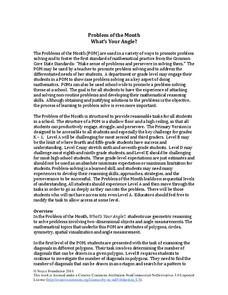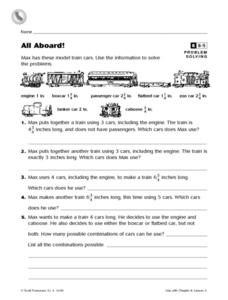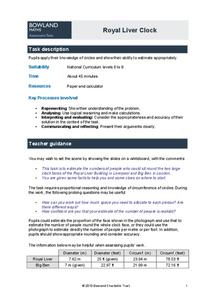Curated OER
Tennis Playing Family
In this secondary mathematics worksheet, high schoolers use logical thinking to solve a verbal problems in which they determine who is the worst tennis player in a family. The one page worksheet contains one problem with the solution.
Curated OER
Reasonable Answers: English Learners
In this ELL, reasonable answers instructional activity, students answer 6 multiple choice, word problems where they must choose the most reasonable answer from 3 choices. A definition of reasonable is provided.
Curated OER
The Grandchildren Problem
For this grandchildren problem, students read facts about grandchildren. They use logical reasoning to determine the birthday of four grandchildren. Students predict the date of the fifth grandchild's birth. This one-page worksheet...
Curated OER
Using Patterns
In this math worksheet, students examine a drawing of a neighborhood made of geometric shapes. Students answer 5 questions about patterns they discover. Then students answer 5 word questions about address numbers by using logical...
Illustrative Mathematics
Seven to the What?!?
Sometimes what seems like the easiest problem is really the most difficult. Your class is first going to reach for their calculators, but will realize the number is too large to evaluate. Now what? This is where the fun and the logical...
Noyce Foundation
The Wheel Shop
Teach solving for unknowns through a problem-solving approach. The grouping of five lessons progresses from finding an unknown through simple reasoning to solving simultaneous equations involving three and four variables. Each lesson...
Noyce Foundation
What's Your Angle?
Math can be a work of art! Reach your artistic pupils as they explore angle measures. A creative set of five problems of varying levels has young learners study interior and exterior angle measures of polygons. The introductory levels...
Curated OER
Proof by Induction
In this induction worksheet, students read word problems. They determine the difference between inductive and deductive reasoning. Students solve the given problem through inductive reasoning. This one-page worksheet contains 1...
Curated OER
All Aboard
In this mathematical reasoning learning exercise, 3rd graders create a catalog page for a toy-train supply store. They list items in order of price (greatest to least amounts). Students are given clues to assist. They answer three...
Curated OER
Delps and Googles
In this mathematical reasoning worksheet, 1st graders are shown shapes named with the nonsense terms of Delps and Googles. They circle shapes with similar characteristics.
Inside Mathematics
Quadratic (2006)
Most problems can be solved using more than one method. A worksheet includes just nine questions but many more ways to solve each. Scholars must graph, solve, and justify quadratic problems.
Bowland
Royal Liver Clock
Using clocks as dining tables? Scholars estimate the number of people that can sit around the face of the clock on the Royal Liver Building in Liverpool. They use estimation to justify their responses.
Curated OER
The Treasure Hunt
In this treasure hunt worksheet, students determine a combination of events that satisfies given conditions. This one-page worksheet contains 1 logic problem. The answer is provideed at the bottom of the page.
Curated OER
Missionaries and Cannibals
In this missionaries and cannibals worksheet, students read a word problem and use logic and deductive reasoning to solve the problem. This one-page worksheet contains one problem. Answers are provided at the bottom of the page.
Curated OER
Use the Clues
In this reasoning worksheet, 2nd graders, after looking over the example, read 3 clues 3 times to find the 3 numbers that make each sum in 3 boxes.
Curated OER
Before, After, Between
In this logical reasoning worksheet, learners view 3 rows of pictures that show children in action. They follow directions that are listed at the bottom of the page to show before, after, and between.
Curated OER
Compare Weight
For this comparing weight word problem worksheet, students use logical reasoning to determine which objects are heavier or heaviest. Students solve six problems.
Noyce Foundation
The Shape of Things
Investigate the attributes of polygons. A thorough set of lessons presents problem scenarios for elementary through high school classes. The first lessons focus on basic characteristics of polygons, including the line of symmetry. As the...
Noyce Foundation
First Rate
Explore distance and time factors to build an understanding of rates. A comprehensive set of problems target learners of all grade levels. The initial problem provides distance and time values and asks for the winner of a race. Another...
Noyce Foundation
Cubism
If cubism were a religion, would you follow it? Lower-level tasks focus primarily on counting the number cubes in a structure and relating the number to surface area. As learners progress to higher-level tasks, isometric drawings and...
Noyce Foundation
Lyle's Triangles
Try five problems on triangles. Levels A and B focus on shapes that can be created from right triangles. Level C touches upon the relationship between the area of a six-pointed star and the area of each triangle of which it is composed....
Noyce Foundation
Piece it Together
Score some problems all related to soccer balls. The first few problems focus on pattern blocks to see relationships between figures. More advanced problems focus on actual soccer balls, the patterns on the balls, and their volumes and...
Center for Mathematics and Technology
Whole Numbers: Using an Area Model to Explain Multiplication
There are many ways to work through a multiplication problem. Using an area model, kids complete several worksheets with different types of multiplication problems, including multiplying by ten, and explain how the new strategies differ...
Curated OER
Critical Thinking - Week 11
In this critical thinking worksheet, students complete problems which require abstract reasoning and logic. They complete logic puzzles involving sums of an array, finding the maximum number of integers under given conditions, and card...

























